Abstract
This paper presents a review of the main trends in the urban air mobility (UAM) sector. After an initial introduction to the key aspects driving the design of aircraft for this type of application and the main characteristics of each type of aircraft developed so far, the focus shifts to the description of the main regulatory frameworks, highlighting the essential requirements that the aircraft must meet at each stage of flight. To translate the aircraft or propeller requirements into design specifications for electric motors, an aerodynamic model is presented. Subsequently, a series of aircraft developed by major industry players is described. In the following section, the key characteristics sought in motors for UAM are outlined, along with various examples of motors developed by leading companies. Additionally, specific design considerations and recommendations are discussed, emphasizing critical aspects such as the adoption of advanced conductors and high-performance cooling systems to enhance power density and efficiency. In conclusion, this review highlights the diverse UAM designs shaping a technological shift in aviation. As prototypes evolve, greater standardization will drive industry growth and support the broader ecosystem, including vertiport providers.
1. Introduction
The world of electric machines, especially rotating ones, is an extremely broad sector undergoing continuous technological evolution. It plays a fundamental role in modern society due to the numerous applications of these technologies, ranging from electric generation to drive systems for machine tools and household appliances and extending to the propulsion of automobiles and passenger transport vehicles (trains, buses). Electric drives are now widely used on aircraft to replace mechanical, hydraulic, or pneumatic actuators for control surface movement or landing gear operation due to their extreme precision and reliability [1,2,3]. The new frontier for the application of these technologies is aeronautical propulsion.
The objective of projects such as urban air mobility and regional air mobility is to enable passenger and cargo sustainable transportation modes by employing a range of newly designed aircraft, known as electric vertical take-off and landing (eVTOL) vehicles. As the name itself suggests, urban air mobility (UAM) focuses on connections within urban areas, enabling short-range travel akin to air taxis, while regional air mobility (RAM) aims to establish links between different metropolitan areas. These markets are expected to provide significant commercial opportunities as they offer consumers the potential to drastically reduce travel times.
The design of eVTOL aircraft is a relatively new field of research. However, it is generally possible to identify seven main drivers for the design process:
- Payload: The goal of any aeronautical project is to make the system as lightweight as possible while simultaneously maximizing its payload capacity.
- Speed: The transition from the departure point to the destination must occur in the shortest possible flight time.
- Range: The aircraft range must be guaranteed between 100 and 400 , depending on the application.
- Noise: The noise pollution generated by the aircraft is a critical factor in an urban scenario, as it ensures the well-being not only of the passengers but also of individuals in the surrounding area.
- Maintainability: Since the profitability of companies supplying motors to airlines is based on its utilization time (and thus the actual flight time of the aircraft), it is essential to ensure that repairs can be carried out as simply and quickly as possible in the event of a malfunction. This minimizes inconvenience to passengers, disruption to the circulation of other aircraft, and helps maintain a profitable business.
- Safety: It is crucial to ensure the safety of the aircraft during flight and to prevent it from posing a risk to the surrounding environment in the event of a failure or malfunction. This is particularly true when the aircraft is carrying passengers. Simplicity in construction also contributes to a higher level of safety.
- Cost: All of these objectives must be met while minimizing the total system cost in order to make the business profitable. Electric technology is generally considered a cheap technology, at least in relation to turbomachinery for aeronautical propulsion. Additionally, UAM operators, such as airlines, aim to offer UAM tickets at a price in line with premium ground transportation services (– the cost of a taxi) and much lower than premium air transport services (e.g., helicopters). Therefore, the cost of ownership of the aircraft must be kept to a very low level.
Moreover, the complexity of aeronautical systems interconnects all of these drivers, making it highly challenging to optimize one without impacting the others.
This new type of urban mobility is accompanied by a range of other challenges, primarily related to energy storage systems (ESSs). The current capacity of widely used batteries for these systems is highly limited, with low energy density significantly constraining flight range. Furthermore, as the ESS is among the most expensive components of the entire system, battery lifespan becomes one of the key drivers in the design process. Certain factors, such as charging speed and frequency, can reduce battery lifespan by as much as [4]. It is therefore crucial to determine, based on the type of infrastructure available, whether it is more advantageous to recharge the battery between flights (as quickly as possible) or to completely replace the battery pack between flights. The latter option, while potentially allowing for controlled charging conditions at the vertiport, involves a complex operation that can influence the overall design of the aircraft.
Given the sensitivity of data related to battery technologies in this specific field, obtaining detailed and reliable information is particularly challenging. Many technical details remain proprietary or are subject to confidentiality agreements, which limits the availability of comprehensive data in the public domain.
Today, the most widely used type of battery is the lithium-ion battery. For this technology, the energy density, as reported by major companies, is approximately [5]. Lithium-sulfur cells are a promising alternative for this kind of applications, as prototype cells currently achieve 350–400 , and this value is expected to grow up to [6,7,8,9]. Sulfur, compared with the active materials commonly used for the lithium-ion technology, has a low density ( vs. of lithium manganese cobalt oxide). This implies that, although lithium-sulfur technology allows for batteries with a higher energy density, they will require a larger volume (per unit of stored energy) [10].
Furthermore, the widespread adoption of these transportation modes also depends on infrastructure-related issues. Key points of interest within cities must be equipped with appropriate vertiports [11], not only to allow for the vertical take-off and landing of eVTOLs but also to ensure battery charging and, eventually, maintenance. The vertiport models (e.g., UrbanV [12] and Skyport [13]) are numerous, depending on space requirements. This also has an impact on the design and maintenance of the aircraft.
Another challenge is associated with the regulation and management of an increasing volume of air traffic, particularly at lower altitudes [14]. The traffic control system, particularly given the push towards autonomous aircraft, must also be capable of handling emergencies, such as the temporary occupation of a vertiport by a malfunctioning aircraft. It must designate areas where emergency landings can be performed without compromising the safety of the urban population.
In urban environments, there is also a need to identify flight paths that are as obstacle-free as possible. Large cities traversed by extensive canal networks or major waterways, such as London, Paris, and particularly Venice and Amsterdam, are well suited for this purpose.
The various types of eVTOLs developed can be classified into four main groups (Figure 1):
- Multicopters: This configuration is relatively simple and can be very efficient during vertical take-off, landing, and hovering. However, lacking wings, multicopters are not efficient during the cruise phase [15]. For this reason, they are primarily suited for UAM applications rather than RAM.
- Lift and cruise: These aircraft merge the multicopter with a standard aircraft for the cruise flight, overcoming the limitations of multicopters. Usually, in order to maximize range, these concepts are designed with fewer, shorter blades. This helps in reducing the drag during cruise flight. However, the small size of the propellers creates a problem in terms of noise emissions, due to the high blade tip speed.
- Tilt rotor (TR): This architecture either involves the wing and propellers, or the propellers alone, tilting to allow the aircraft transition form hover to forward flight. In general, this configuration requires a more complex design, aimed at achieving a compromise solution that ensures good efficiency during all phases of flight while reducing inert mass during the cruise phase, compared with lift and cruise configurations [16]. The vertical take-off phase, however, requires the propellers to be large and rotating at low speed. This means that either the motors need to be large and heavy or a gearbox is required.
- Ducted vectored trust (DVT): this solution features ducted propellers, which offer advantages in terms of both efficiency and safety. The presence of the duct reduces losses near the propeller tips, enhancing efficiency, and allows the propellers to continue operating even in the event of collisions with birds or partial propeller damage. Ducted propellers can be integrated into the structure in two main ways: they can be placed away from the airframe, similar to conventional aircraft, or they can be integrated into the wings or fuselage structure, which results in greater aerodynamic coupling.

Figure 1.
eVTOL main groups [17].
All of these architectures will be analyzed in detail in the following sections.
This work is organized as follows: Section 2 presents the regulatory framework and the main eVTOL requirements based on the European and American prescriptions. In Section 3, the operation of the propeller is first analyzed to provide guidelines for identifying the aircraft speed and thrust requirement. This is followed by a simple model to translate these requirements into torque and speed specifications for the electric motor, aiding in the preliminary design phase. Section 4 presents a series of design solutions developed by various industry players. Finally, Section 5 outlines the different types of electric motors best suited for UAM applications, providing recommendations and considerations for use during the design phase.
2. Regulatory Framework: European and American Perspectives
When it comes to VTOL aircraft, including eVTOL, regulations and safety standards are still evolving. Regulatory authorities such as the European Union Aviation Safety Agency (EASA) and Federal Aviation Administration (FAA) are working on specific certification frameworks to address the unique aspects of these aircraft.
The EASA introduced the Special Condition for VTOL (SC-VTOL) in 2019 to establish basic airworthiness and operational requirements for VTOL aircraft. This document provides requirements for critical safety aspects. For reference, the full SC-VTOL document and associated guidelines can be found on the EASA website [18].
Most of the regulations specified for VTOL aircraft have been considered valid in publications after 2019, even when these aircraft are electrically propelled.
The classification of VTOL and eVTOL aircraft based on mass is a key point in aviation regulation because mass impacts several certification aspects, from safety requirements to operational limitations. The EASA and FAA established categories based on the take-off mass, adapting them to the specific flight characteristics and operation types for VTOLs.
2.1. VTOL Takeoff Mass-Based Classification
2.1.1. EASA Classifications (Special Condition VTOL-SC-VTOL)
- Light VTOL: For aircraft with a maximum take-off mass of up to (approximately 4400 pound) [19]. This category typically includes VTOLs designed to carry few passengers or limited cargo and is subject to simplified certification requirements.
- Heavy VTOL: Includes aircraft over . In this case, safety and certification requirements are stricter, as these aircraft have a more significant impact on the environment, public safety, and infrastructure. Regulations generally require advanced redundancy, flight control, and risk mitigation systems in case of failures.
2.1.2. FAA Classifications (for Light VTOL Aircraft)
The FAA tends to follow Part 23 regulations for small VTOLs, particularly those with a take-off mass up to (around 6000 pounds) [20]. This regulation covers both STOL aircraft as well as VTOLs. Like the EASA, the FAA can adapt certification requirements to specific weight classes to ensure safety and stability.
2.2. VTOL Application-Based Classification
In addition to the take-off mass classification, a second subdivision based on the intended use of the aircraft (passenger transport, cargo, commercial applications, etc.) can be performed.
- Commercial and transport VTOLs: these aircraft, which are generally heavier, must comply with stricter regulations regarding safety systems and the ability to operate in congested environments, such as urban areas.
- Light VTOLs for limited operations: aircraft under (especially in the eVTOL sector) may be regulated as ultralight, but only if used for non-commercial purposes.
2.3. Reference Values for VTOL Speeds and Altitudes
The EASA and FAA are still developing exact standards for VTOL aircraft operating in urban environments. The EASA regulations, however, identify three different take-off modes (Figure 2): conventional take-off (ConvTO), elevated ConvTO (EConvTO), and vertical take-off (VTO). The first two can also be adapted for a VTOL aircraft in case of an emergency, but VTO is the designated mode for the urban environment. The different phases of a VTO are described in the following.

Figure 2.
Take-off paths according to EASA regulations [18].
2.3.1. Take-Off
The take-off phase begins with the aircraft on the ground and ends when the aircraft reaches an altitude of (1000 ft) above the take-off point, i.e., a safe altitude for transition. The aircraft should reach the take-off safety speed (), which is the minimum speed at which the aircraft can safely switch from vertical flight mode to horizontal flight mode, and proceed at a speed as close as possible to this one until it is (200 ft) above the take-off elevation. At this point, the aircraft no longer relies on vertical thrust from the rotors and begins to generate lift through its wings, similar to conventional fixed-wing flight. is typically between knots (approximately ).
2.3.2. Climb
After the transition, the VTOL enters a climb phase to gain altitude and reach the desired cruise level. This phase can be divided into different segments, according to the minimum prescribed gradient (Figure 3):
- First segment: From the altitude at which is reached (typically for small VTOL aircraft , i.e., feet) to . The minimum gradient required is .
- Second segment: From to . The minimum gradient required is .

Figure 3.
Take-off segments according to EASA regulations [18].
It is important to note that the values reported for the various flight altitudes referenced by the regulations are the same as those applicable to Category A helicopters. Furthermore, the aircraft must be capable of operating safely in different scenarios, from departure at sea level to a departure altitude of .
The target speed that the aircraft must achieve at the end of the take-off and transition phase, when horizontal flight is fully established and the aircraft is operating at optimal performance for climb or cruise, is called final take-off speed (). Usually, is similar to , but in some configurations, it may be slightly lower, ranging from (approximately ) to avoid excessive energy consumption and minimize noise.
2.3.3. Cruise
This phase is one of the most important flight parts, during which the aircraft operates horizontally and stably, with maximum efficiency in terms of fuel or energy consumption. During this phase, the aircraft has completed the transition from vertical flight (take-off or landing) to horizontal flight and stabilizes in a flight profile that can be sustained over a long period of time. Cruise is typically the phase of flight in which the aircraft reaches and maintains its most efficient flight speed. Some eVTOL designs, such as those by Joby Aviation [21], Lilium [22], and Vertical Aerospace [23], are testing cruise speeds around , with capabilities for operating in urban settings without compromising passenger comfort or safety. These vehicles are typically designed for short-range commuting or city-to-city transport and aim for high energy efficiency over distances ranging from . A fundamental use case is connecting city centers to airports (e.g., Manhattan–JFK) or one airport to another (e.g., Heathrow–Gatwick).
Other eVTOLs designed for urban mobility typically cruise at speeds between knots (approximately ), though some may reach up to 200 knots (around ) for longer-range missions or vehicles designed for passenger transport over greater distances.
2.3.4. Vertical Landing
EASA regulations identify two different landing modes: conventional landing (ConvL) and vertical landing (VL). VL (Figure 4) is the designated mode for UAM applications as it allows for compliance with obstacle separation. The landing procedure starts at a point along the flight path called the landing decision point (LDP), defined as the last point from which a balked landing is guaranteed. The LDP can be reached at a velocity equal or lower to the reference speed (), i.e., the speed at which the speed variations due to turbulence or other environmental conditions can be safely managed.
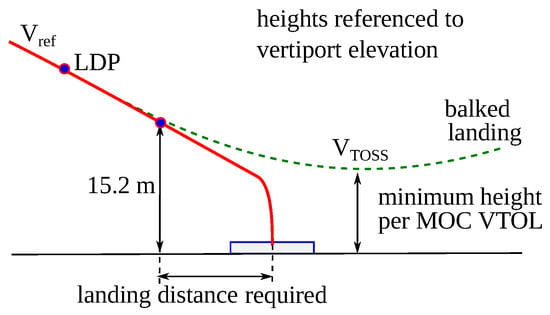
Figure 4.
Vertical landing path according to EASA regulations [18].
The landing distance required is the horizontal distance needed from the aircraft to come to a full stop from a point (50 ft) above the landing surface.
2.3.5. Balked Landing
According to EASA regulations, in the case of a balked landing, the aircraft should not only be able to regain without changing configuration but also able to sustain a second climb phase again, satisfying the minimum climb requirements described in Section 2.3.2 in order to perform a go-around. This ability is crucial in the determination of the energy reserve and design of the energy storage system (ESS).
2.4. Accelerations
For passenger comfort (see ISO 2631 [24] for reference), the aircraft acceleration should be kept around 1 g. During take-off, the recommended maximum values are approximately g, while for landing, they range between g. In emergency maneuvers, aircraft accelerations may reach around 2 g.
However, from a structural standpoint, the design is influenced by different reference values: the structure must be capable of withstanding positive accelerations up to 3 g and negative accelerations down to g.
2.5. Acoustic Footprint
The noise pollution of VTOL aircraft, especially eVTOL models, is one of the most studied aspects, as these aircraft are designed to operate in urban environments where noise reduction is essential. The FAA and EASA are still finalizing specific noise limits for VTOLs, with a particular focus on urban air mobility (UAM) operations. The goal is for VTOLs to produce less noise than conventional helicopters, especially during take-off and landing (when helicopters usually generate between dB(A)), to minimize acoustic impact in residential areas. Some references on ideal noise levels for UAM suggest that VTOLs should emit dB(A) near landing and take-off areas [25], a value that is comparable with heavy road traffic.
3. Propulsion System Model
To transform the aircraft requirements during the various phases of flight, a simplified model based on the momentum theory for an actuator disk can be employed.
This theory starts from the assumption that:
- The airflow through the rotor disk is uniform.
- Non-ideal effects like compressibility and flow separation can be neglected.
3.1. Aerodynamic Loads
According to this approach, for a stationary hovering condition, the thrust imparted by the propeller can be expressed as
The airflow rate entering the actuator disk (Figure 5) is given by the product of the air density, , the propeller area, A, and the induced velocity, , whose expression depends on the flight condition; represents the the change in velocity imposed by the disk.
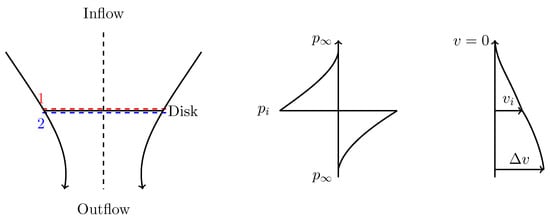
Figure 5.
Actuator disk concept for rotor in hover.
According to Bernoulli’s equation, it can be written as
can also be written as
The induced velocity is consequently
where the quantity is called disk loading (DL) and is a key parameter in rotorcraft design, expressing the relationship between the weight supported by the rotor system and the area of the rotor disk. Table 1 summarizes some typical values for different kinds of rotorcraft.

Table 1.
Design choices for different rotorcraft [26].
The corresponding induced power is then
The same analysis can be repeated in the case of vertical flight at a velocity , yielding once again to (6), but has the following expression:
The thrust can be expressed as
where represents the value of in hover at the same trust. The corresponding induced power is then
Equation (12) can be used in a preliminary stage of the design to roughly estimate the power needed to the shaft using an adequate safety coefficient.
The total power needed, however, is composed of two more components as suggested in [27,28]: the profile power needed to counter the aerodynamic torque of the spinning rotor blades; and the parasitic power needed to counter the parasitic shape drag, caused mainly by viscous forces.
It can therefore be written that
It is common practice in the aeronautical field to express aerodynamic forces (lift, drag, and thrust) and power in terms of dimensionless coefficients. For a disc of radius R rotating at speed , thrust and power can be rewritten as a function of the tip velocity of the propeller :
To normalize the induced velocity and the forward flight speed to the blade tip speed of the rotor, three non-dimensional coefficients are introduced: the induced inflow ratio, the advance ratio, and the rotor solidity factor, respectively:
Another useful parameter for comparing the performance of various aircraft is the ratio. Namely, it is defined as
where is the total blade area. This ratio is the non-dimensional blade loading corresponding to the non-dimensional disc loading . Typical values of are between .
In order to describe each of these terms, a more detailed analysis is necessary, based on the blade element theory. This approach applies the airfoil theory to a rotating blade, starting from the assumption that the latter is rigid.
In vertical flight, including hover, the main complication is the need to integrate the elementary forces along the blade span. Figure 6 shows the acting forces of a generic blade section at radius y. The resultant flow speed seen by the section is
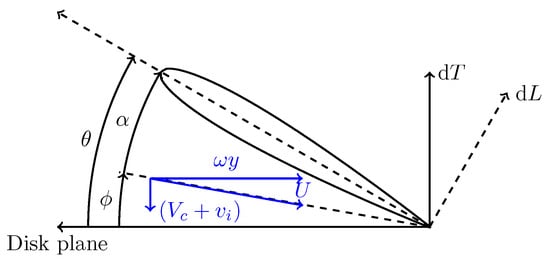
Figure 6.
Blade section flow conditions in vertical flight.
The angle between the flow direction and the plane of rotation is called inflow angle and is denoted by . It is given by
The angle of incidence is
where is the blade pitch angle, determined by the pilot control.
Taking into account that is usually small, and assuming that stall and compressibility effects can be neglected, it can be derived that
where and the lift slope factor .
For a blade with zero twist, is constant, and, for uniform induced velocity, is also constant. In these circumstances, (24) integrates to
Modern blades, however, have a negative twist, decreasing the pitch angle towards the tip in order to not compromise the load distribution. It is common practice to take the reference pitch angle at ; thus takes the form
and becomes
It can be demonstrated that the assumption of constant inflow leads to underestimating the thrust coefficient by ∼ [27]. This confirms that this hypothesis can be assumed valid in many practical cases.
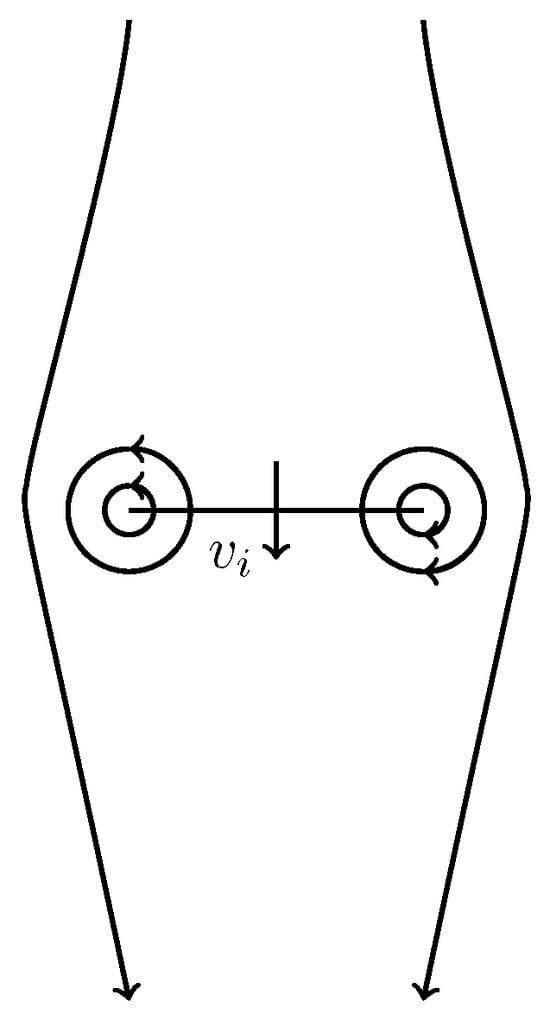
Figure 7.
Schematic representation of tip vortices.
The coefficient B typically ranges between and and takes into account that the portion of the propeller closest to the hub generates drag rather than lift due to the vortices that form in the vicinity. This formula results in a lower thrust produced by the rotor compared with the one prescribed by (25) by . This amounts to a increase in induced power.
Starting from the knowledge of the thrust coefficient and the drag coefficient (specific for the selected airfoil), the various power coefficients can be determined.
The induced power coefficient , always under the constant inflow hypothesis, can be estimated, in the case of vertical flight at speed as
where the coefficient takes into account the non-uniformity of the inflow and can include the contribution of tip losses. It is suggested that .
The profile power coefficient can be estimated as
where is the mean drag coefficient and k is an empirical correction factor. For a preliminary design, or in the case of a simple hover (), its contribution can be neglected.
The parasitic power coefficient can be estimated as
where is the equivalent flat plate correlated to rotor area. Suggested values for this ratio are around .
Non-Ideal Flow Analysis
The two assumptions made so far are now relaxed; the case of non-uniform induced velocity will be considered, and an approach that accounts for the effects of fluid compressibility will be described.
A non-uniform induced velocity of the disk can be accounted for by considering that the variation of can be expressed according to the blade element theory as
and, rewriting (11), as
Equating these two expressions leads to a distribution of given by
can consequently be calculated according to (24) as a function of r.
Typically, to minimize the aircraft noise pollution without compromising performance, the tip speed of the propeller is kept below Mach during cruise and below Mach during take-off and landing. The higher the tip speed, the less valid the assumption of fluid incompressibility. To account for these effects, if the blade geometry is known at every section—along with the lift coefficient () and drag coefficient () of the aerodynamic profile at each section—as a function of the attack angle and of the Reynolds number, a more general blade element formulation can be applied. Given
and defining the blade solidity in position r
the variation of along the blade span can be written as
The term is called rotational interference factor and is defined from
can finally be derived as
The thrust coefficient of the propeller obtained with this approach provides a highly accurate estimate of the thrust, following the same procedure described earlier.
3.2. Ducted Fans
The ducted fan consists of a free fan surrounded by a fairing, whose primary function is to control the exit section of the system. It can be demonstrated that this solution allows for an induced velocity from the propeller that is higher than that of a free propeller, albeit with ∼ increase in power demand. A comparison at equal power output from the propulsion system reveals that the ducted fan can generate ∼ more thrust than a free propeller. This effect is primarily due to the increased airflow intake into the propulsion system. Additionally, the ducted fan restricts radial flow, significantly reducing tip losses.
3.3. Motor Requirements
Once the thrust and the required power are known, the requirements for the electric motor can be determined. Assuming an aircraft with n motors and that the required thrust and power are evenly distributed among them, the torque requested to the shaft for each motor can be estimated as:
Consequently, the motor speed can be derived as
4. Developed Aircraft
Over the years, various companies and aerospace agencies have developed different types of aircraft, depending on the intended applications. In general, the stringent regulations regarding passenger safety, combined with the substantial thrust requirements during take-off, have led to the development of two distinct approaches. The first approach involves the use of a small number of large, high-power propulsion units (typically 1–4), driven by highly fault-tolerant electric motors. Conversely, the second approach employs a greater number of smaller propulsion units (typically between 6 and 36) capable of compensating for the failure of one or more units. This latter approach, known as distributed electric propulsion (DEP), appears to be the most suitable for prototype development as it not only ensures high levels of aircraft safety but also offers economic advantages by relying on less complex and more standardized systems.
The following sections describe a series of aircraft, either under development or already prototyped, designed for various applications, ranging from cargo transportation to medical support.
4.1. STOL Aircraft and Gliders
An example of an STOL electric aircraft is the Velis Electro [29] (Figure 8), a single-motor, two-seat, fixed-wing aircraft capable of reaching a cruising speed of approximately (at sea level and utilizing of the motor power).

Figure 8.
Velis Electro.
Its endurance is around , excluding the reserve time required for emergency maneuvers. The battery recharge time is approximately . The motor delivers a maximum take-off power (MTOP) of , enabling a climb rate of approximately .
With a wingspan of , a length of , and a height of , the Velis Electro has an empty weight of and a maximum payload capacity of , resulting in a maximum take-off mass (MTOM) of approximately .
A particularly unique aircraft developed by Velis [30] is the Pipistrel Taurus Electro G4 two-seat glider (Figure 9). This aircraft is equipped with a two-blade propulsion unit that can be deployed from a compartment located in the rear of the fuselage when needed. The propulsion system is capable of delivering a maximum power of for up to one minute. This feature translates into performance metrics such as a climb rate of and a best glide ratio of 41:1 at a speed of . The maximum maneuvering speed is .
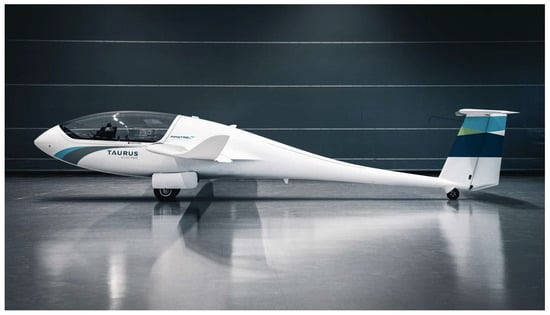
Figure 9.
Pipistrel Velis Taurus glider.
With a wingspan of ∼, a length of , and a height of (when the propeller is extended), the Pipistrel Taurus Electro G4 has an empty weight of and an MTOM of approximately .
4.2. Multicopters
An example of a multicopter is the Volocopter VoloCity [31] (Figure 10), a two-seat aircraft designed for air taxi applications. The first prototype flew in September 2017 without a crew and in January 2018 with a crew onboard. It is capable of supporting autonomous flight, pending regulatory approval, with a configuration that can switch between one pilot + one passenger and two passengers.
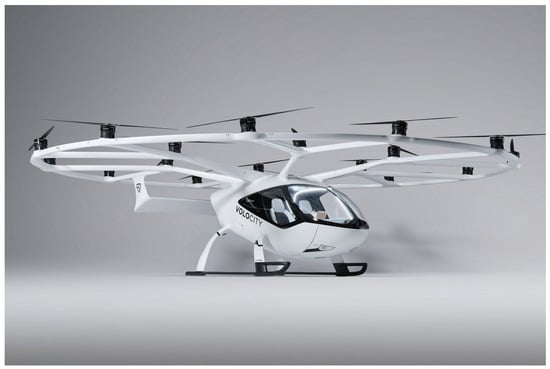
Figure 10.
Volocopter VoloCity multicopter.
The propulsion system consists of 18 two-blade propellers with a diameter of each, driven by SPM motors and powered by 9 separate exchangeable, rechargeable, lithium-ion batteries. This setup provides a cruising speed of ∼ and a range of around and a relatively low noise emission of 65 dB(A) at .
With a tip-to-tip distance of , a length of , and a height of , the VoloCity aircraft has an empty weight of , with a maximum payload of and an MTOM of approximately .
4.3. Lift and Cruise
The lift and cruise eVTOL developed by EVE Embraer [32] (Figure 11) is an aircraft designed to transport four passengers, with a pilot onboard until regulations permit autonomous flight.

Figure 11.
EVE Embraer lift + cruise.
The propulsion system consists of eight two-blade propellers used during vertical take-off and landing phases, and a five-blade propeller positioned at the tail for use during cruise flight.
This configuration ensures an average range of .
One of the alternatives proposed by Airbus is the CityAirbus [33] (Figure 12), a lift + cruise eVTOL designed for passenger transportation and air taxi applications (accommodating three passengers and one pilot or four passengers in the autonomous version). It is also envisioned for medical transport.
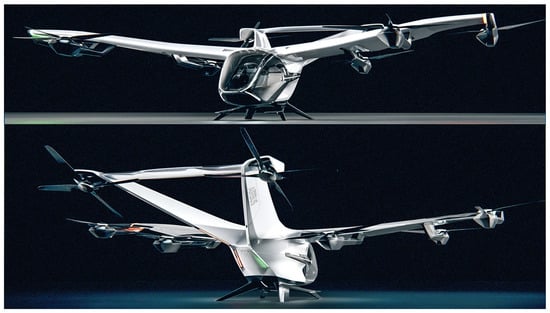
Figure 12.
Airbus CityAirbus lift + cruise.
The aircraft features a fixed forward-swept wing and a U-shaped tail, equipped with eight four-blade propellers. Of these, two are positioned at the tail and are tilted during the cruise to provide the necessary horizontal thrust.
This thrust-vectoring capability of the propulsion system makes it more versatile than a traditional lift and cruise system, such as the one described previously. As will be seen later, solutions of this type are widely adopted.
This propulsion system, however, enables a range of approximately and a cruising speed of .
With a wingspan of ∼, Airbus CityAirbus has an empty weight of .
Another lift and cruise solution is the Archer Midnight [34] (Figure 13), a fixed-wing aircraft capable of transporting four passengers (with a pilot in the manned version, though autonomous operation will be possible when regulations allow) over a range of at a cruise speed of and an altitude of .

Figure 13.
Archer Midnight lift + cruise.
The propulsion system consists of 12 propellers: six two-blade propellers are used exclusively during vertical take-off and landing phases, while the remaining six, each with five blades, are tiltable and enable cruise flight. Power is supplied by six independent battery packs.
The noise pollution during cruise flight, as declared by the company, is particularly low, estimated at around 45 dB(A). With an MTOM of , the aircraft can carry a maximum payload of .
Wisk’s solution for passenger transport and air taxi operations is the Aero Generation 6 [35] (Figure 14), an autonomous fixed-wing aircraft with human supervision, capable of carrying four passengers.
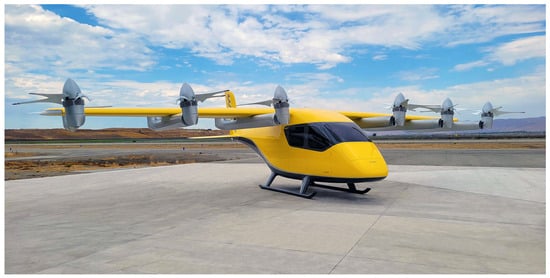
Figure 14.
Wisk Aero lift + cruise.
The propulsion system consists of 12 propellers. Six fixed propellers, located on the trailing edge of the wing, feature four blades each and provide thrust exclusively during take-off and landing. The remaining six propellers, located on the leading edge of the wing, are tilt propellers with five blades each, which are the sole providers of thrust during cruise.
The system offers a range of approximately and a recharge time of about . The aircraft has a cruising speed of at altitudes ranging between and , with a maximum payload capacity of .
The VX4 (Figure 15), developed by Vertical Aerospace [36], is a fixed-wing eVTOL of the lift and cruise type, designed for UAM and RAM applications. It is capable of carrying one pilot and four passengers, with a maximum payload of .
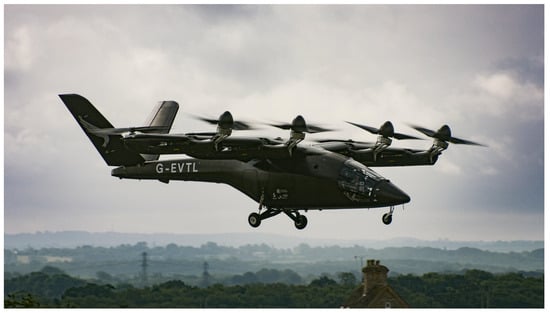
Figure 15.
VX4 lift + cruise.
The propulsion system consists of eight propeller-driven units. Four are fixed in a vertical position and located at the rear of the wing, each equipped with four blades. The other four are tilt-capable and positioned at the front of the wing, each featuring five blades.
With a wingspan of ∼, a length of ∼, and an overall height of ∼, this system enables a range of 150 km and a cruising speed of .
VX4 underwent an accident during a flight test in August 2023. A full-scale root cause investigation highlighted that the incident occurred due to the detachment of a blade from the right inner propeller, caused by an issue with the adhesion between the blade’s coating and its spar. This detachment created an imbalance that led to the failure of the propeller mount. As a result, three motors on the aircraft right side lost power, causing an uncontrolled descent. The company stated that the issue found in the prototype will not substantially impact the development program as next prototypes will feature improved design and manufacturing processes, upgraded propellers, and advanced systems. The flight campaign resumed in 2024, achieving promising results.
Table 2 compares the main characteristics of the eVTOLs presented in this section.

Table 2.
Main characteristics of different types of lift and cruise eVTOLs.
4.4. Tilt Rotor and Tilt Wing
The Joby Aviation S4 [21] (Figure 16) is a five-seat tilt-rotor VTOL (one pilot + four passengers) designed for air taxi applications, such as transport to and from major airports in metropolitan areas.
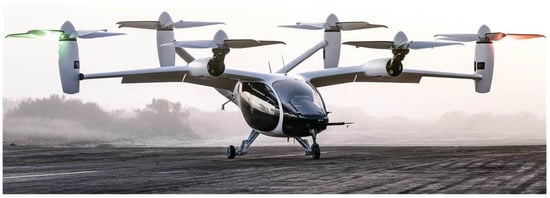
Figure 16.
Joby S4 tilt-rotor VTOL.
Its propulsion system comprises six rotors that transition from a vertical position during take-off and landing to a horizontal position for cruising. Four of these rotors rotate the entire nacelle housing the electric motor, while the two at the front of the aircraft tilt only the propeller. The system is powered by six dual three-phase electric motors, each capable of delivering a peak power of (with a peak torque of and a nominal torque of ). Each drive system, including the dedicated motor electronics, has a mass of .
The power supply is provided by batteries with a specific energy capacity of , enabling a range of (including reserves) and a maximum cruising speed of .
The total empty mass of the system is , with an MTOM of , resulting in a maximum payload capacity of approximately .
Its declared acoustic footprint is particularly low, measuring just 45 dB(A) during cruise.
The Supernal S-A2 [37] (Figure 17) is another example of a tilt-rotor aircraft, but it differs from the previous example in two aspects. First and foremost, it is a fixed-wing aircraft. Secondly, the propulsion system consists of eight propellers: four located near the leading edge of the wing and the other four near the trailing edge. The trailing-edge propellers can be tilted downward and are counter-rotating relative to the leading-edge propellers.

Figure 17.
Supernal S-A2 tilt-rotor aircraft.
With this system, the S-A2 can achieve a cruise speed of at an altitude of , with noise pollution below 65 dB(A) during hover and 45 dB(A) during cruise. Its range, supported by a high-voltage, fast-charging battery pack, is between 39 and .
The aircraft is designed to carry four passengers in addition to the pilot. However, not only an autonomous version is planned, but the interior can also be easily reconfigured to accommodate only two passengers or to operate in cargo mode.
An alternative to the previously mentioned tilt rotors is the tilt-wing aircraft developed by Airbus, the Vahana [38] (Figure 18). This is a fully autonomous aircraft that has successfully completed a flight test campaign covering over 500 nautical miles and that has also been the subject of in-depth analyses available in the literature [39].

Figure 18.
Airbus Vahana tilt-wing aircraft.
Unlike the previous aircraft, in this case, the entire wings rotate to enable the transition from vertical take-off and landing to cruise mode.
The propulsion system consists of eight rotors, powered by a battery, which provides a range of . This makes the aircraft particularly suitable for UAM applications.
Table 3 compares the main characteristics of the eVTOLs presented in this section.

Table 3.
Main characteristics of different types of tilt-rotor and tilt-wing eVTOLs.
4.5. Ducted Vectored Thrust
The Lilium Jet [22] (Figure 19) is a perfect example of ducted vectored thrust. It is an aircraft with an MTOM of 3175 kg, designed to transport one pilot and six passengers, with a range of approximately and capable of reaching a cruising speed of at .
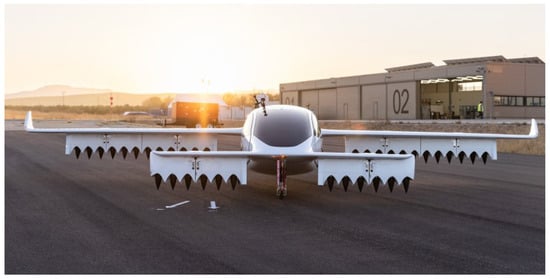
Figure 19.
Lilium Jet with vectored thrust fans.
These performance characteristics are enabled by a propulsion system consisting of 36 ducted fans, which are rotated depending on the flight phase. Currently, Lilium has not released specific details regarding the exact power values for each individual electric motor or for the entire propulsion system of the Lilium Jet. However, based on similar aircraft, it can be estimated that the power for each motor ranges between .
The ducted fans are also designed to absorb vibrations as much as possible and minimize acoustic pollution. The company claims to achieve noise levels up to six times lower than those of a helicopter during take-off.
5. Electric Motor Characteristics for eVTOL
To address the various drivers guiding the design of an eVTOL aircraft as described so far, an electric motor dedicated to driving a propeller must exhibit three main characteristics:
- High power density and efficiency: this ensures that, for a given power output, the electric motor weight and size are minimized, contributing to the overall performance and range of the aircraft.
- Low torque ripple: this minimizes motor vibrations, which directly reduces the system noise pollution, a critical factor for urban operations.
- Robust fault-tolerance and post-fault operation capabilities: these ensure that the system can continue functioning effectively even in the event of a fault, enhancing reliability and safety (and profitability). At the same time, great importance must be given to self-diagnostics and data analysis for fault prediction. This enables preventive maintenance actions and maximizes asset availability. All of this translates into specific requirements for both design (e.g., the integration of sensors where necessary) and testing (including endurance testing, artificial fault introduction, reliability enhancement testing, and environmental testing—particularly for air-cooled motors).
The motor design is ultimately influenced by the type of propulsor being developed. For example, a ducted propulsor operates at high speed and low torque to provide the necessary thrust for sustaining the aircraft. However, the presence of the duct imposes constraints on the axial length and external diameter of the motor. Conversely, a propulsor with a large-diameter propeller requires a motor designed to operate at high torque and low rotational speed, due to the significant inertia of the propeller.
Among conventional motor topologies, the permanent-magnet synchronous motor (PMSM) is well suited for this kind of application due to its high power density. In addition, it has a low torque ripple, leading to good NVH quality. Moreover, several strategies have been studied to minimize its cogging torque [40].
PMSMs have already been designed for the actuation of subsystems in airplanes and helicopters, replacing their mechanical or hydraulic counterparts [41,42,43]. Given the critical nature of the propulsion system, increasing efforts are being made to study configurations that limit the occurrence of faults while simultaneously enabling post-fault operation of the system for an adequate period of time.
However, PMSMs fault-tolerant capabilities can be enhanced by implementing multiphase windings, which, while increasing power density [44] and facilitating post-fault operation [45,46], inevitably complicate the control strategy due to the mutual interactions between two or more three-phase winding sets [47].
One of the solutions developed by Siemens (Munich, Germany) [48] is the SP200D (Figure 20), a peak radial flux motor designed for the propulsion of one of the early versions of the CityAirbus.
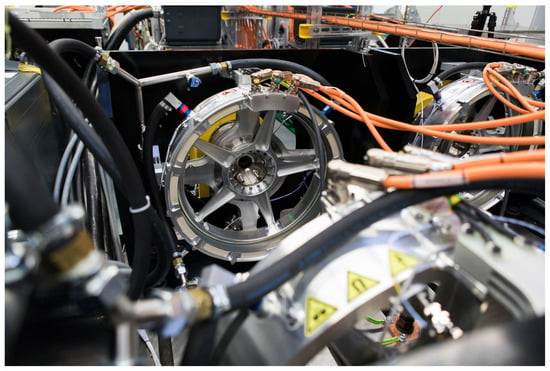
Figure 20.
Siemens SP200D.
An interesting alternative solution is the use of a dual stator system, as proposed by [49]. This configuration, reported in Figure 21, features two separate three-phase windings, which can be controlled independently, ensuring excellent fault tolerance and optimal utilization of the available volume. However, due to the high number of degrees of freedom in the control, especially when multiphase windings are employed on both stators, this technology still requires further research.
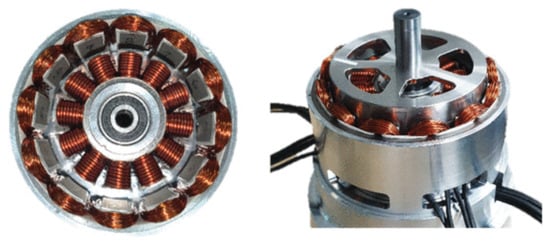
Figure 21.
Dual stator geometry proposed in [49].
Some companies have developed various axial flux alternatives. These PMSM geometries generally offer high power density due to their compact dimensions, particularly in the axial direction.
YASA (Oxford, UK) [50] and Rolls-Royce (Blankenfelde-Mahlow, Germany) [51] have collaborated, for example, in the design of the propulsion system for the Electroflight P1, conceived as an electric racing aircraft. The project is based on a variant of the YASA 750R (Figure 22), an axial flux motor with a peak power of and a power density .
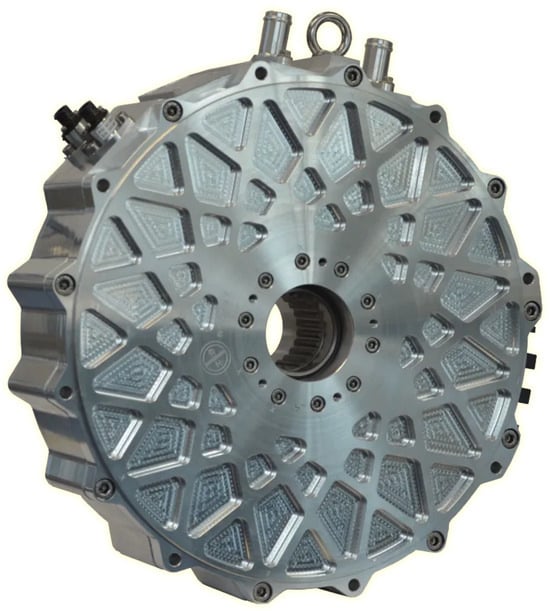
Figure 22.
Yasa 750R axial flux PMSM.
Rolls-Royce has also developed its own class of motors for UAM applications. These are transverse flux machines (TFMs), designed to be adaptable to various types of eVTOL. Figure 23 shows the electrical power unit (EPU). However, the future development of this type of machine is tied to that of Rolls-Royce’s electric division, which has been set to close.
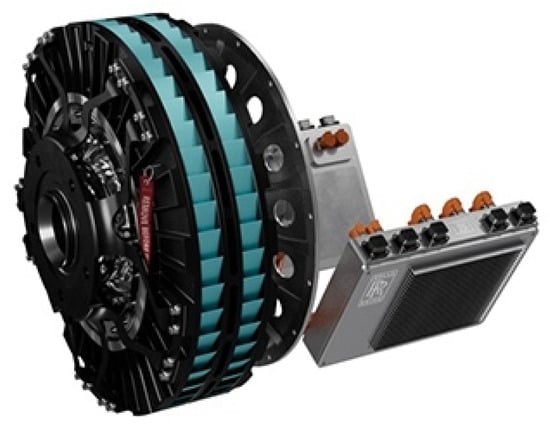
Figure 23.
Electrical power unit (EPU) designed by Rolls-Royce.
Emrax (Kamnik, Slovenia) [52], on the other hand, developed the Emrax 268 (Figure 24), which is used in the Pipistrel Pantera, a hybrid aircraft developed by Pipistrel. The motor, with a peak power of (delivered at 4500 rpm), is specifically designed to meet EASA standards, making it the first motor certified for general aviation by this authority.
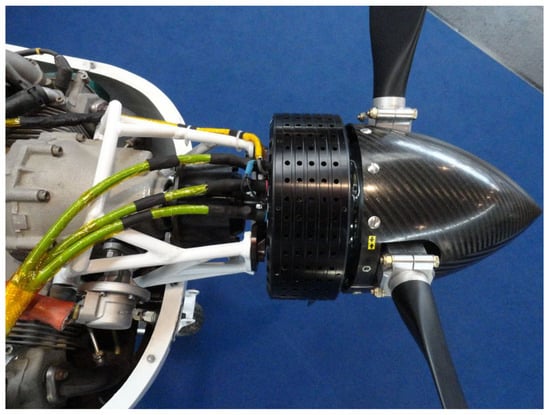
Figure 24.
Emrax 268 axial flux PMSM.
The main characteristics for each motor are listed in Table 4.

Table 4.
Main characteristics of different types of motor presented.
5.1. Power Density Improvement Strategies
State-of-the-art PMSMs developed for aeronautical propulsion have power densities ranging between [53].
These values can be increased in other ways as well as using multiphase systems as mentioned above. For example, the use of innovative magnetic materials with high permeability, high saturation flux density, and low specific losses such as grain-oriented electrical steel (GOES) and iron-cobalt (Co-Fe) Permendur electrical steel alloys was investigated in [54,55].
It is also convenient to use permanent magnets with high energy density (NdFeB, SmCo), even if their realization involves highly polluting processes. For this reason, alternative designs that completely avoid the use of rare earth magnets are being studied in other sectors such as the automotive industry. Magnet recycling techniques are also being studied.
Another possibility is to design the motor to work at higher supply voltages (typically around ) and with much higher current densities. While a naturally air-cooled electric motor typically operates at a current density of about under nominal conditions, motors designed for UAM applications can run as high as . This allows for higher power output while keeping weight and size compact, but it necessitates the design of an effective cooling system to manage the increased thermal load. Furthermore, increasing the supply voltage introduces challenges related to conductor insulation [56], complicating their design and reducing the effective cross-sectional area of the stator slots.
To make better use of the section of the stator slots, the use of hairpin conductors has been studied [57,58,59,60]. Their application also minimizes the stator slot opening, helping to reduce torque ripple. However, for motors operating at high speed, the increase in Joule losses due to AC effects (skin effect, proximity effect) must be carefully evaluated. Failure to perform this could result in a significant reduction in the efficiency of the electric machine.
5.2. Advanced Cooling Strategies
Thermal management is one of the most critical aspects in the design of an electric motor for aeronautical propulsion, especially when aiming to increase the current densities at which the motor operates. Certain types of propellers, such as ducted fans, provide forced airflow that undoubtedly helps dissipate the heat generated by the motor’s operation. However, forced convection alone is rarely sufficient to keep the motor temperature within acceptable limits (which are primarily determined by the insulation classes of the materials used and the variation of their electro-magnetic and mechanical properties). Therefore, liquid cooling systems (glycol–water, oil) are often used. The solutions presented so far, for example, utilize oil cooling systems with varying flow rates, up to for the YASA 750R.
Because much of the thermal load is associated with the dissipation of Joule losses in copper, recent research has been exploring the use of hollow conductors [61]. This type of conductor allows for better heat management by providing a path for coolant to flow through the conductor, thus improving the cooling efficiency. This design is particularly effective in high-power applications, reducing the overall thermal load on the system and enhancing the motor performance and lifespan. The hollow structure, however, complicates the insulation process, as it may become more difficult to ensure that the electrical and thermal insulation is properly maintained along the entire length of the conductor. Additionally, ensuring secure and reliable connections at both ends of the hollow conductors is crucial to prevent any electrical faults, power losses, or potential mechanical failures due to thermal expansion or vibrations. These issues must be carefully addressed during the design and manufacturing stages to maintain the overall reliability of the system. With 3D printing and additive manufacturing technologies [62], it is possible to design and manufacture hollow conductors with highly complex and precise shapes that may be difficult or impossible to achieve using traditional manufacturing methods (Figure 25). This allows for optimized conductor designs that improve both electrical and thermal performance while also ensuring better insulation and more reliable connections. Additionally, these technologies enable rapid prototyping and customization, helping to streamline the development process of such advanced components.
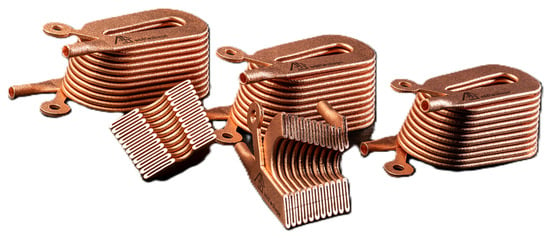
Figure 25.
Three-dimensionally printed hollow conductors from Addtoshape [63].
6. Conclusions
The development of urban air mobility (UAM) vehicles represents an important step toward sustainable and efficient urban transportation. This review has outlined the primary features of UAM aircraft, the various design typologies, and both the strengths and limitations of this emerging technology. While UAM offers significant potential, particularly in terms of reduced travel times and emissions, key challenges remain, most notably in the realm of battery technology, which still struggles to meet the demands of power density and operational efficiency required for this application.
The regulatory framework, still evolving under the guidance of organizations like EASA and FAA, will play a pivotal role in shaping the future of this industry, providing standards to ensure safety and reliability.
The aerodynamic model based on blade element theory presented herein demonstrates a practical approach to evaluating the torque and speed requirements of electric motors across different flight phases.
The overview of UAM in Section 4 shows the plurality of design solutions that are currently being explored. Such innovative vehicles mark a step change to the typical aircraft design developed over the last decades and have produced a technology acceleration that is already impacting other aviation products. The current portfolio of UAM prototypes is likely to progressively converge towards a higher commonality of architectures and features; this will not only help the industry to develop, but also the broader ecosystem (e.g., vertiports providers).
The review of electric motors for UAM applications underscores their significant potential for further development, identifying key areas where increasingly advanced and innovative solutions are needed. In particular, improvements in power density and efficiency will require not only enhanced motor designs and optimized thermal management strategies but also the adoption of advanced conductors and high-performance cooling systems to address the demanding operational conditions of these vehicles.
To further enhance the power density and efficiency of electric propulsion systems, this review offered recommendations aligned with current research directions, emphasizing the importance of material innovation, thermal management, and advanced motor designs. By addressing these challenges, the UAM industry can move closer to realizing its vision of widespread, reliable, and sustainable air mobility.
Funding
This research received no external funding.
Conflicts of Interest
Although the author Stefano Vianello was an employee of Rolls-Royce Electrical, the research was conducted without any commercial or financial collaborations that could constitute a potential conflict of interest.
Abbreviations
The following abbreviations are used in this manuscript:
| DEP | Distributed electric propulsion |
| DL | Disk loading |
| DVT | Ducted vectored thrust |
| EASA | European Union Aviation Safety Agency |
| EPU | Electrical power unit |
| ESS | Energy storage system |
| eVTOL | Electric VTOL |
| FAA | Federal Aviation Administration |
| GOES | Grain-oriented electrical steel |
| LDP | Landing decision point |
| MTOM | Maximum take-off mass |
| MTOP | Maximum take-off power |
| NVH | Noise vibration and harshness |
| P/L | Payload |
| PMSM | Permanent-magnet synchronous motor |
| RAM | Regional air mobility |
| RMS | Root mean square |
| SC-VTOL | Special Condition for VTOL |
| STOL | Standard take-off and landing |
| TFM | Transverse flux machine |
| TR | Tilt rotor |
| UAM | Urban air mobility |
| VTOL | Vertical take-off and landing |
References
- Cao, W.; Mecrow, B.C.; Atkinson, G.J.; Bennett, J.W.; Atkinson, D.J. Overview of Electric Motor Technologies Used for More Electric Aircraft (MEA). IEEE Trans. Ind. Electron. 2012, 59, 3523–3531. [Google Scholar] [CrossRef]
- Gerada, C.; Galea, M.; Kladas, A. Electrical machines for aerospace applications. In Proceedings of the 2015 IEEE Workshop on Electrical Machines Design, Control and Diagnosis (WEMDCD), Torino, Italy, 26–27 March 2015; pp. 79–84. [Google Scholar] [CrossRef]
- Sayed, E.; Abdalmagid, M.; Pietrini, G.; Sa’adeh, N.M.; Callegaro, A.; Goldstein, C.; Emadi, A. Review of Electric Machines in More/Hybrid/Turbo Electric Aircraft. IEEE Trans. Transp. Electrif. 2021, 7, 2976–3005. [Google Scholar] [CrossRef]
- Lv, S.; Wang, X.; Lu, W.; Zhang, J.; Ni, H. The Influence of Temperature on the Capacity of Lithium Ion Batteries with Different Anodes. Energies 2022, 15, 60. [Google Scholar] [CrossRef]
- Lin, D.; Liu, Y.; Cui, Y. Reviving the lithium metal anode for high-energy batteries. Nat. Nanotechnol. 2017, 12, 194–206. [Google Scholar] [CrossRef] [PubMed]
- Samaniego, B.; Carla, E.; O’Neill, L.; Nestoridi, M. High specific energy Lithium Sulfur cell for space application. E3S Web Conf. 2017, 16, 08006. [Google Scholar] [CrossRef]
- Berg, E.J.; Villevieille, C.; Streich, D.; Trabesinger, S.; Novák, P. Rechargeable Batteries: Grasping for the Limits of Chemistry. J. Electrochem. Soc. 2015, 162, A2468. [Google Scholar] [CrossRef]
- Offer, G.; Zhang, T.; Marinescu, M.; Minton, G.; Purkayastha, R.; O’Neill, L.; Wild, M. Understanding Lithium Sulfur Cells, Modelling the Mechanisms behind Voltage- and Capacity-Drop during Discharge. In ECS Meeting Abstracts; The Electrochemical Society, Inc.: Philadelphia, PA, USA, 2016; p. 775. [Google Scholar] [CrossRef]
- Hagen, M.; Hanselmann, D.; Ahlbrecht, K.; Maça, R.; Gerber, D.; Tübke, J. Lithium–Sulfur Cells: The Gap between the State-of-the-Art and the Requirements for High Energy Battery Cells. Adv. Energy Mater. 2015, 5, 1401986. [Google Scholar] [CrossRef]
- Cerdas, F.; Titscher, P.; von Drachenfels, N.; Schmuch, R.; Winter, M.; Kwade, A.; Herrmann, C. Exploring the Effect of Increased Energy Density on the Environmental Impacts of Traction Batteries: A Comparison of Energy Optimized Lithium-Ion and Lithium-Sulfur Batteries for Mobility Applications. Energies 2018, 11, 150. [Google Scholar] [CrossRef]
- (EASA), E.U.A.S.A. Prototype Technical Design Specifications for Vertiports. 2022. Available online: https://www.easa.europa.eu/en/document-library/general-publications/prototype-technical-design-specifications-vertiports (accessed on 12 December 2024).
- UrbanV. Available online: https://www.urbanv.com/it/uv-0-vertiporto-di-test/ (accessed on 12 December 2024).
- Skyport. Available online: https://skyports.net/vertiports/ (accessed on 12 December 2024).
- Kopyt, A.; Kaczmarek, K.; Sochacki, M.; Stephens, C. Urban Air Mobility Traffic Analysis Tool for Airspace Involving Vertiport Hub Operations to Examine Simulated Conflicts. In Proceedings of the 2024 AIAA DATC/IEEE 43rd Digital Avionics Systems Conference (DASC), San Diego, CA, USA, 29 September–3 October 2024; pp. 1–6. [Google Scholar] [CrossRef]
- Pradeep, P.; Wei, P. Energy-Efficient Arrival with RTA Constraint for Multirotor eVTOL in Urban Air Mobility. J. Aerosp. Inf. Syst. 2019, 16, 263–277. [Google Scholar] [CrossRef]
- Chauhan, S.; Martins, J. Tilt-Wing eVTOL Takeoff Trajectory Optimization. J. Aircr. 2019, 57, 1–20. [Google Scholar] [CrossRef]
- Chahba, S.; Sehab, R.; Morel, C.; Krebs, G.; Akrad, A. Fast Sizing Methodology and Assessment of Energy Storage Configuration on the Flight Time of a Multirotor Aerial Vehicle. Aerospace 2023, 10, 425. [Google Scholar] [CrossRef]
- (EASA), E.U.A.S.A. Easy Access Rules for Small Category VCA. 2024. Available online: https://www.easa.europa.eu/en/document-library/easy-access-rules/easy-access-rules-small-category-vca (accessed on 10 December 2024).
- (EASA), E.U.A.S.A. Special Condition for VTOL and Means of Compliance. 2024. Available online: https://www.easa.europa.eu/en/document-library/product-certification-consultations/special-condition-vtol (accessed on 10 December 2024).
- (FAA), F.A.A. Urban Air Mobility (UAM) Concept of Operations. 2023. Available online: https://www.faa.gov/air-taxis/uam_blueprint (accessed on 10 December 2024).
- Joby Aviation. Available online: https://www.jobyaviation.com (accessed on 14 January 2025).
- Lilium. Available online: https://jet.lilium.com (accessed on 14 January 2025).
- Vertical Aerospace. Available online: https://vertical-aerospace.com (accessed on 14 January 2025).
- ISO 2631-1:1997; Mechanical Vibration and Shock—Evaluation of Human Exposure to Whole-Body Vibration—Part 1: General Requirements. International Organization for Standardization: Geneva, Switzerland, 1997.
- Rizzi, S.A.; Huff, D.L.; Boyd, D.D.; Bent, P.; Henderson, B.S.; Pascioni, K.A.; Sargent, D.C.; Josephson, D.L.; Marsan, M.; He, H.B.; et al. Urban Air Mobility Noise: Current Practice, Gaps, and Recommendations. 2020. Available online: https://ntrs.nasa.gov/citations/20205007433 (accessed on 14 January 2025).
- Russell, C.R.; Basset, P.M.; Onera. Conceptual Design of Environmentally Friendly Rotorcraft—A Comparison of NASA and ONERA Approaches. In Proceedings of the Vertical Flight Society 71st Annual Forum, Virginia Beach, VA, USA, 5–7 May 2015.
- Seddon, B.; Newman, S. Basic Helicopter Aerodynamics, 2nd ed.; Wiley: Hoboken, NJ, USA, 2001. [Google Scholar]
- Kim, K.C. Analytical Calculations of Helicopter Torque Coefficient (CQ) and Thrust Coefficient (CT) Values for the Helicopter Performance (HELPE) Model; US Army Research Laboratory: Adelphi, MD, USA, 1999. [Google Scholar]
- Velis Electro. Available online: https://www.pipistrel-aircraft.com/products/velis-electro/ (accessed on 14 January 2025).
- Pipisterl Taurus Electro G4. Available online: https://www.pipistrel-aircraft.com/products/taurus-electro/ (accessed on 15 January 2025).
- Volocopter Volocity. Available online: https://www.volocopter.com/en/solutions/volocity (accessed on 15 January 2025).
- EVE Air Mobility. Available online: https://www.eveairmobility.com/ (accessed on 15 January 2025).
- Airbus CityAirbus. Available online: https://www.airbus.com/en/innovation/energy-transition/hybrid-and-electric-flight/cityairbus-nextgen (accessed on 17 January 2025).
- Archer. Available online: https://archer.com/ (accessed on 17 January 2025).
- Wisk Aero. Available online: https://wisk.aero/aircraft/ (accessed on 17 January 2025).
- Vertical Aerospace VX4. Available online: https://vertical-aerospace.com/meet-the-vx4/ (accessed on 17 January 2025).
- Supernal. Available online: https://www.supernal.aero/aircraft/ (accessed on 17 January 2025).
- Airbus Vahana. Available online: https://www.airbus.com/en/innovation/low-carbon-aviation/urban-air-mobility/cityairbus-nextgen/vahana (accessed on 17 January 2025).
- Perdolt, D.; Thiele, M.; Milz, D.; May, M.; Kuchar, R.; Hornung, M. Comparison of Multi-Fidelity Rotor Analysis Tools for Transitional and Low Speed Flight Regimes. In Proceedings of the Deutscher Luft-und Raumfahrtkongress 2021, Bremen, Germamy, 31 August–2 September 2021. [Google Scholar] [CrossRef]
- Bianchi, N.; Bolognani, S. Design techniques for reducing the cogging torque in surface-mounted PM motors. IEEE Trans. Ind. Appl. 2002, 38, 1259–1265. [Google Scholar] [CrossRef]
- Bianchi, N.; Michieletto, D.; Cinti, L.; Contò, C.; Carlet, P.G.; Brunetti, M.; Nesci, A. Permanent Magnet Synchronous Motor Drives for More-Electric Aircraft. In Proceedings of the 2022 International Symposium on Power Electronics, Electrical Drives, Automation and Motion (SPEEDAM), Sorrento, Italy, 22–24 June 2022; pp. 871–876. [Google Scholar] [CrossRef]
- Brunetti, M.; Nesci, A.; Bianchi, N. Conceptual design of a distributed electric anti-torque system for enhanced helicopter safety and performance. CEAS Aeronaut. J. 2023, 15, 545–563. [Google Scholar] [CrossRef]
- Fabri, G.; Parasiliti, F.; Tursini, M.; Villani, M.; Castellini, L. PM brushless motor for helicopters electric tail rotor drive system. In Proceedings of the 2017 IEEE International Electric Machines and Drives Conference (IEMDC), Miami, FL, USA, 21–24 May 2017; pp. 1–7. [Google Scholar] [CrossRef]
- Barcaro, M.; Bianchi, N.; Magnussen, F. Analysis and tests of a dual three-phase 12-slot 10-pole permanent magnet motor. In Proceedings of the 2009 IEEE Energy Conversion Congress and Exposition, San Jose, CA, USA, 20–24 September 2009; pp. 3587–3594. [Google Scholar] [CrossRef]
- Bianchi, N.; Stoppato, A. Thermal Analysis of a Multi-Three-Phase PM Motor in Nominal, Overload and Post-Fault Operations. In Proceedings of the 2024 International Symposium on Power Electronics, Electrical Drives, Automation and Motion (SPEEDAM), Napoli, Italy, 19–21 June 2024; pp. 806–811. [Google Scholar] [CrossRef]
- Michieletto, D.; Bianchi, N.; Brunetti, M. Dual Three-phase Motor Fault Tolerance for Modern Transport. In Proceedings of the 2021 International Aegean Conference on Electrical Machines and Power Electronics (ACEMP) & 2021 International Conference on Optimization of Electrical and Electronic Equipment (OPTIM), Brasov, Romania, 2–3 September 2021; pp. 405–412. [Google Scholar] [CrossRef]
- Kallio, S.; Andriollo, M.; Tortella, A.; Karttunen, J. Decoupled d-q Model of Double-Star Interior-Permanent-Magnet Synchronous Machines. IEEE Trans. Ind. Electron. 2013, 60, 2486–2494. [Google Scholar] [CrossRef]
- Siemens. Available online: https://www.siemens.com/it/it.html (accessed on 20 December 2024).
- Hwang, S.W.; Son, D.K.; Park, S.H.; Lee, G.H.; Yoon, Y.D.; Lim, M.S. Design and Analysis of Dual Stator PMSM with Separately Controlled Dual Three-Phase Winding for eVTOL Propulsion. IEEE Trans. Transp. Electrif. 2022, 8, 4255–4264. [Google Scholar] [CrossRef]
- Yasa. Available online: https://yasa.com/ (accessed on 20 December 2024).
- Rolls Royce. Available online: https://www.rolls-royce.com/products-and-services.aspx (accessed on 20 December 2024).
- Emrax. Available online: https://emrax.com/ (accessed on 28 December 2024).
- Zucker, O.S.; Blumenau, L.; Liu, C.; Yu, P.K. New High Specific Power Motor Technology for All-Electric Class III UAVs. In Proceedings of the 2018 IEEE International Power Modulator and High Voltage Conference (IPMHVC), Jackson, WY, USA, 3–7 June 2018; pp. 58–63. [Google Scholar] [CrossRef]
- Hebri, M.; Rebhaoui, A.; Bauw, G.; Lecointe, J.P.; Duchesne, S.; Zito, G.; Abdenour, A.; Santos, V.; Mallard, V.; Maier, A. Power density improvement of axial flux permanent magnet synchronous motor by using different magnetic materials. COMPEL Int. J. Comput. Math. Electr. Electron. Eng. 2023, 42, 929–946. [Google Scholar] [CrossRef]
- Jiang, X.; Huang, W.; Cao, R.; Hao, Z.; Jiang, W. Electric Drive System of Dual-Winding Fault-Tolerant Permanent Magnet Motor for Aerospace Applications. IEEE Trans. Ind. Electron. 2015, 62, 7322–7330. [Google Scholar] [CrossRef]
- Wang, J.; Dong, J.; Niasar, M.G.; Zhu, G.; Bauer, P. Power Density Limits of Propulsion Motor for Electric Aircraft: A Study on Insulation Thickness. In Proceedings of the 2024 International Conference on Electrical Machines (ICEM), Torino, Italy, 1–4 September 2024; pp. 1–7. [Google Scholar] [CrossRef]
- Arzillo, A.; Nuzzo, S.; Braglia, P.; Franceschini, G.; Barater, D.; Gerada, D.; Gerada, C. An Analytical Approach for the Design of Innovative Hairpin Winding Layouts. In Proceedings of the 2020 International Conference on Electrical Machines (ICEM), Online, 23–26 August 2020; Volume 1, pp. 1534–1539. [Google Scholar] [CrossRef]
- Carbonieri, M.; Venturini, G.; Popescu, M. A Practical Approach to Hairpin Winding Design: Patterns Investigation, Feasibility Verification and Fractional Slot Solutions. In Proceedings of the 2022 IEEE Energy Conversion Congress and Exposition (ECCE), Detroit, MI, USA, 9–13 October 2022; pp. 1–8. [Google Scholar] [CrossRef]
- Bianchi, N.; Berardi, G. Analytical Approach to Design Hairpin Windings in High Performance Electric Vehicle Motors. In Proceedings of the 2018 IEEE Energy Conversion Congress and Exposition (ECCE), Portland, OR, USA, 23–27 September 2018; pp. 4398–4405. [Google Scholar] [CrossRef]
- Berardi, G.; Bianchi, N. Design Guideline of an AC Hairpin Winding. In Proceedings of the 2018 XIII International Conference on Electrical Machines (ICEM), Alexandroupoli, Greece, 3–6 September 2018; pp. 2444–2450. [Google Scholar] [CrossRef]
- Wu, F.; EL-Refaie, A.M. Additively Manufactured Hollow Conductors with Integrated Cooling for High Specific Power Electrical Machines. In Proceedings of the 2020 International Conference on Electrical Machines (ICEM), Gothenburg, Sweden, 23–26 August 2020; Volume 1, pp. 1497–1503. [Google Scholar] [CrossRef]
- Wu, F.; EL-Refaie, A.M.; Al-Qarni, A. Additively Manufactured Hollow Conductors Integrated with Heat Pipes: Design Tradeoffs and Hardware Demonstration. IEEE Trans. Ind. Appl. 2021, 57, 3632–3642. [Google Scholar] [CrossRef]
- Addtoshape. Available online: https://www.addtoshape.com/ (accessed on 20 January 2025).
Disclaimer/Publisher’s Note: The statements, opinions and data contained in all publications are solely those of the individual author(s) and contributor(s) and not of MDPI and/or the editor(s). MDPI and/or the editor(s) disclaim responsibility for any injury to people or property resulting from any ideas, methods, instructions or products referred to in the content. |
© 2025 by the authors. Licensee MDPI, Basel, Switzerland. This article is an open access article distributed under the terms and conditions of the Creative Commons Attribution (CC BY) license (https://creativecommons.org/licenses/by/4.0/).